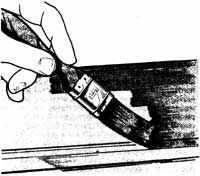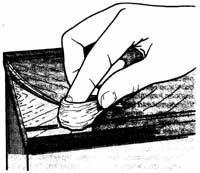How to Antique Glaze Furniture
Antiquing is the technique of glazing a base finish to simulate age or create an interesting color effect. Enamel is the most common base for antiquing, but varnished, shellacked, and lacquered surfaces can also be glazed. Antiquing is not recommended for real antiques, but it can work wonders with a thrift-store find or a cheap unfinished piece.
Materials
Advertisement
Antiquing kits, sold in paint and hardware stores, include both base enamel and a coordinated or contrasting glaze. Many colors and combinations are available. Any sound flat or gloss enamel, varnish, shellac, or lacquer finish can be treated with glaze. Look for transparent antiquing glaze, in muted tones of umber and burnt sienna or in white, gold, black, or colors. The greater the contrast between base and glaze, and the brighter the glaze color, the more obvious it will be that the piece of furniture is antiqued. If you're working over an existing finish, make sure the glaze is compatible.
Application Techniques
The base coat: A piece of furniture to be antique-finished must be clean and in good repair. Remove all hardware. If you're antiquing an unfinished piece of furniture or covering an old finish, sand and seal the wood. On finished pieces to be covered completely, clean the wood thoroughly and then treat it with sanding deglosser to dull the surface; if there are still any shiny spots, buff them with No. 0000 steel wool. Sand out any chips in the old finish so that the surface is smooth.
On pieces to be glazed over an existing finish, clean the wood thoroughly with a detergent solution and dry it well;
then wipe it with denatured alcohol. Let the prepared wood
dry for 24 hours.
If you're working on an unfinished piece or covering an old finish, apply a base finish coat of flat or gloss enamel. Let the enamel dry completely. If necessary, apply a second base coat; sand the surface lightly, clean it, and apply the enamel. Let the final coat of enamel dry completely, at least two days.
The glaze:When the base coat is completely dry, or the existing base finish is prepared, apply the antiquing glaze. Use a contrasting color for an obvious antiqued look, a muted umber or burnt sienna to simulate age. Apply the glaze with a clean brush.

Antiquing glaze sets quickly, and the surfaces you glaze first will retain more color than the ones you glaze later. Working on one surface at a time, apply glaze to moldings, carvings, and decorated areas, and then to flat areas. On large surfaces, the glaze can be applied in several stages,
if necessary.
Let the glaze dry until it starts to dull, as directed by the manufacturer. Then carefully wipe the glaze off with a soft cloth, flat surfaces first, so that the base coat retains color only at areas to be highlighted. Work from the center of each surface out to the edges, wiping carefully along the grain of the wood. Remove the glaze completely from high spots; leave some of it in low spots, in corners, in
carvings or decorations, and along edges and moldings.
The surfaces wiped last will retain the most glaze; leave
the parts you want to highlight until last.
Let the glazed surface dry completely, as directed by the manufacturer.
Textured Glazes: For a bolder look, you can get different design effects by texturing the glaze with different materials, and leaving more glaze on. Before using these texturing methods on a piece of furniture, experiment on a piece of scrap wood given an enamel base coat.

Texturing the glaze can be done with almost anything -- cheesecloth, crumpled newspaper, plastic wrap, a sponge,
or whatever you have on hand. Remove a little glaze or almost all of it, whichever you prefer. For a wood-grain texture, use a cheesecloth pad; wipe the glaze off in long, even strokes, and then dab it with a scrap piece of carpeting or a stiff-bristled brush. Crumpled newspaper or plastic wrap produces a marble effect; a dry sponge makes a random stipple. Use a burlap bag or a towel for a scratched look.
For a leather texture, let the glaze get almost dry;
then pad it with a piece of fiberglass insulation.
Protecting the Surface
Antiqued finishes can be left uncoated, but for a more
durable surface, seal the piece of furniture with semigloss or high-gloss varnish. Make sure the varnish is compatible with the antiqued finish. Apply the varnish directly over the antiquing.
If you are looking for another way to create a worn-out look, check out the next section for guidelines on when and how to flyspeck your furniture piece.
